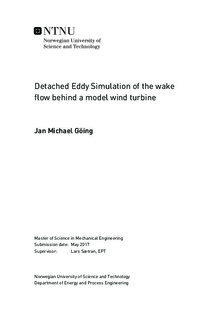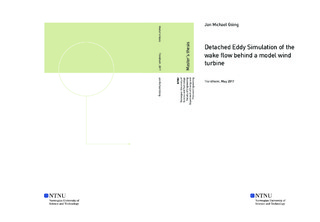| dc.contributor.advisor | Sætran, Lars | |
| dc.contributor.author | Göing, Jan Michael | |
| dc.date.accessioned | 2017-09-15T14:00:36Z | |
| dc.date.available | 2017-09-15T14:00:36Z | |
| dc.date.created | 2017-05-10 | |
| dc.date.issued | 2017 | |
| dc.identifier | ntnudaim:16756 | |
| dc.identifier.uri | http://hdl.handle.net/11250/2454906 | |
| dc.description.abstract | In times of renewable energy the planning of wind parks and the improvement
of the total efficiency has become a major field of research. In order to the optimal
positioning of a wind cluster a precise analysis of the wake properties behind a tur-
bine is necessary. Due to the increasing computer performance, numerical models
have become an important tool for the precise analysis of the turbulent wake flow.
In this study the wake characteristics are calculated with a Delayed - Detached
- Eddy - Simulation (DDES) using a sliding mesh technique. The simulation is
based on a model wind turbine with a diameter of 0.89 m and a test area which
corresponds to the wind tunnel geometry of the department of energy and process
engineering from the NTNU. A validation of DDES with an experimental Laser
- Doppler - Anemometry (LDA) matches well with the results. The simulation
calculates the velocity components and the turbulence kinetic energy sufficiently
accurate. In addition, the coherent structure of a vortex shedding and a significant
frequency at 1p in the near wake is located with a Proper - Orthogonal - Decompo-
sition. The final part of this report shows the trajectory of the same turbine with
a yaw angle of γ = 30◦. The simulation is based on the same numerical conditions
and describes an unexpected trajectory of the velocity deficit. | |
| dc.language | eng | |
| dc.publisher | NTNU | |
| dc.subject | Produktutvikling og produksjon, Energi-, prosess- og strømningsteknikk | |
| dc.title | Detached Eddy Simulation of the wake flow behind a model wind turbine | |
| dc.type | Master thesis | |

